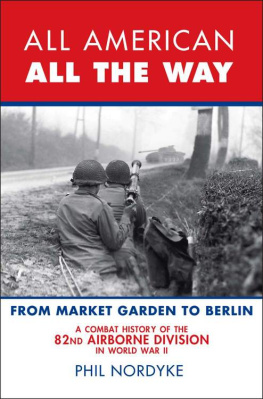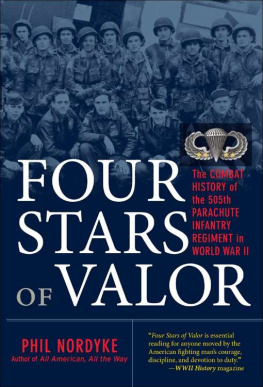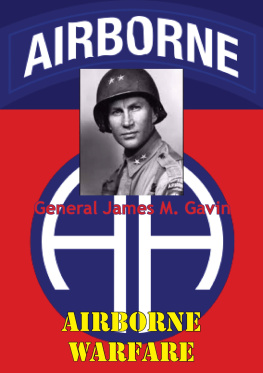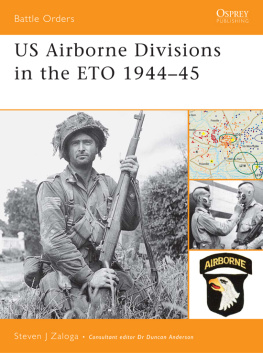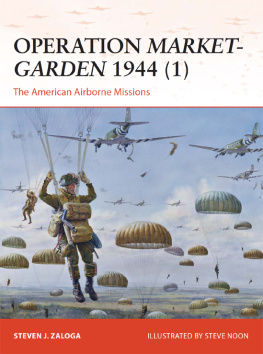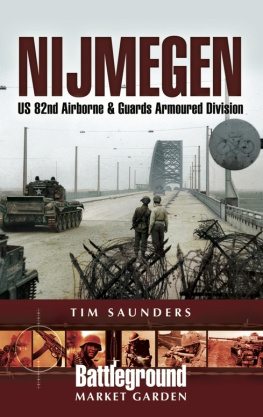ALL AMERICAN
ALL THE WAY
FROM MARKET GARDEN TO BERLIN
THE COMBAT HISTORY OF THE
82ND AIRBORNE DIVISION
IN WORLD WAR II
PHIL NORDYKE

CONTENTS
Dedicated to my wife, Nancy,
and my children, Jason, Amy, and Robert
MAPS
ACKNOWLEDGMENTS
Many people deserve my gratitude for contributing directly and indirectly to the completion of this work. First, I want to thank my family, beginning with my parents. My father, Zyra Jr., helped me to develop an interest in history and an appreciation for the U.S. military. I developed a love for reading and writing as a result of the efforts of my mother, Marjorie. My wife, Nancy, deserves special thanks for having faith in me when this project was just an idea and for putting up with me during the research, writing, and editing processes. She tirelessly supported the project by mailing almost two-thousand questionnaires, assisted in many of the videotaped interviews, traveled countless miles to museums and veterans residences, and provided constructive feedback on the manuscript. My children, Jason, Amy, and Robert, also deserve thanks for their patience during the many side trips to battlefields of the 82nd Airborne Division while we vacationed in Europe. My elder son, Jason, provided tremendous assistance between semesters at college, locating and contacting many veterans using World War II company rosters and formulating some of the company-specific questionnaires. Amy took an interest in the project, providing much emotional support despite being away at college. Robert gave valuable help by using his computer skills and knowledge of Internet search engines to locate veterans.
Any work of this sort would not be possible without those great authors who came before. Cornelius Ryan pioneered the technique of using the words of the veterans to tell the stories in his two landmark works, The Longest Day and A Bridge Too Far. Mr. Ryan graciously donated his wealth of research material to Ohio University in Athens, Ohio, for others to utilize. Many thanks to Doug McCabe, Curator of Manuscripts, Robert E. and Jean R. Mahn Center for Archives and Special Collections, the Alden Library, Ohio University, for providing the materials referenced in this book.
A second historian and author, Dr. Stephen E. Ambrose, has done more to educate the American public about the sacrifices of World War II combat veterans than probably any author. Dr. Ambrose established the National D-Day Museum and the Eisenhower Center in New Orleans, Louisiana, to preserve the oral histories and written accounts collected for his monumental works, D-Day and Citizen Soldiers. I owe a great debt to Martin K. A. Morgan, Research Historian, National D-Day Museum, and the curator of the Eisenhower Center World War II collection for the copies of oral histories and written accounts.
The 82nd Airborne Division War Memorial Museum at Fort Bragg, North Carolina, was the source of a great deal of the primary source material for this book. Dr. John Duvall, Museums Chief, and Betty Rucker, Collections Manager, gave me total access to the RidgwayGavin Archives at the museum. I am deeply in their debt.
I appreciate the photos, maps, and after-action reports obtained through the generous assistance of Joe Hays, Museum Director, at the Silent Wings Museum in Lubbock, Texas.
Many thanks go to Ericka L. Loze, Librarian, Donovan Research Library, Fort Benning, Georgia, for her tireless work in obtaining for me monographs of 82nd Airborne Division veterans from the librarys massive collection.
I want to recognize and thank others who have provided research materials for this work. Guy LoFaro and Normand Thomas sent materials that I needed from the U.S. Army Military History Institute and the U.S. Army Center of Military History. Starlyn Jorgensen gave me access to her history of the 456th Parachute Field Artillery Battalion and Doc Hardies account. Albert N. Parker gave me access to some of the key 507th veterans accounts. Rick Erny graciously sent copies of World War II rosters of the 325th Glider Infantry Regiment. Bob Burns and Robert Slivatz provided the unit journal, contact information for veterans, and filled in the blanks regarding much of the action of the 80th Airborne Antiaircraft (Antitank) Battalion. Jan Bos, in the Netherlands, sent his history of the 376th Parachute Field Artillery Battalion.
The book publishing process was new to me, after spending my entire career in the high tech industry. My literary agent, Ms. Gayle Wurst, Princeton International Agency for the Arts, did a great job of representing my interests with and educating me about the publishing industry. Author and historian Ed Ruggero provided much appreciated counsel regarding the business aspects of book publishing.
I owe a great deal of thanks to Richard Kane, Editor, Zenith Press, who has been a pleasure to work with from the contract through the editing process to the final product. Bob Kane did a wonderful job with suggestions for improvement of the manuscript. The copyeditor, Tom Kailbourn, did a great job getting the manuscript ready for publication.
Special thanks to the cartographer, Phil Schwartzberg, Meridian Mapping, Minneapolis, Minnesota, for the fine maps he produced.
My greatest appreciation is for the contributions of the veterans of the 82nd Airborne Division. Space will not permit me to mention by name and thank all of the veterans that provided contributions for the book. I must begin by thanking General Jack Norton, Colonel Mark Alexander, and Colonel Ed Sayre for their support and for inspiring me to write this book. I owe an enormous debt to 82nd veteran Don Lassen and his Static Line magazine. The publication provided most of the contact information for the more than two-thousand veterans of the division. In each of the unit organizations I found key individuals who were instrumental in opening the door to their respective associations. Ray Fary was of immense assistance in providing material regarding the 80th AA Battalion. Al Nemeth gave me much information and contacts for the 307th Airborne Engineer Battalion. I received invaluable help from Wesley Ko and Wayne Pierce with 325th Glider Infantry Association in providing exposure through the Tow Line newsletter and for written accounts that Mr. Pierce had gathered during the research for his fine book, Lets Go! Ray Grossman and Tom Mattingly were of special help in providing contacts, accounts, and help with the 456th Parachute Field Artillery Battalion. T. Moffatt Burriss, Ed Dodd, Jim Megellas, and Ed Sims, all veterans of the 504th, were of great assistance. Jim Megellas, author of the great book All The Way To Berlin, gave me great advice about the publishing process and great contacts in the business. I am indebted to many veterans of the 505th RCT Association, particularly Frank Bilich, Chris Christensen, Robert Franco, Don McKeage, and Joe Tallett for having confidence in my abilities and for encouraging the membership to contribute their accounts. The late Jim Blue and O. B. Hill, along with Francis Lamoureux with the great 508th Association made available their personal material as well as contact information for the members. Doug Dillard with the 551st PIB Association was instrumental in getting accounts by the veterans of the unit for the book.
Finally, I owe the most gratitude to the more than nine-hundred veterans of the division and their families who contributed to the book. It is with regret that the size of the book didnt allow for each and every veterans account to be included. They will, however, be included in future regimental histories and books about each of the campaigns.

